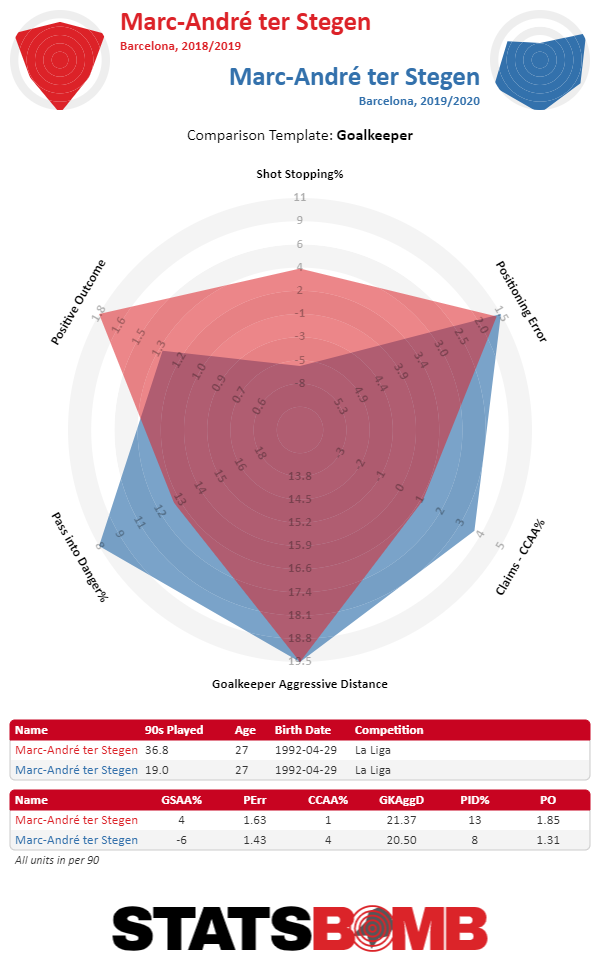Spanish football seems to be losing its hold over the rest of European football. For five years running, a La Liga club won the Champions League. Liverpool's win over Spurs severed that streak . . . in Madrid of all places. Atlético Madrid, Barcelona and Real Madrid were eliminated from the competition in a variety of embarrassing ways. Ajax humiliated Real Madrid at the Bernabéu with Sergio Ramos watching from the stands after picking up a yellow card on purpose to ‘clear the slate’ for games deeper into the competition. Atético Madrid lost 3-0 to Juventus without getting a shot on target despite taking a two-goal lead to Turin. And Barcelona were hijacked by Liverpool at Anfield in a historic collapse by the Spanish side. At the midway point to the season, these are the clubs filling the top three slots in La Liga, but not one has made a truly convincing start. Yet as their respective attacks wane, these three boast salacious amounts of talent at one position. I argue that the first, second and third best goalkeepers in the world are playing in La Liga. Aside from Allisson at Liverpool, there are rarely any other names thrown into the hat when talking about the world’s best. Marc-André ter Stegen, Thibaut Courtois and Jan Oblak are the crème de la crème of glovemen. Who’s better? Who will win the Zamora trophy — the award given to the best keeper in La Liga based on goals conceded — and how important are they to their teams? Goalkeepers don’t always rise to fulfil the best of their traits but fall to the weaknesses of their team’s defensive frailties. As the last line of defence, they are handy scapegoats when things go wrong. Interpreting a goalkeeper’s form can be like interpreting Talmudic texts but with Courtois, Oblak and ter Stegen it's easy to see these are three very effective goalkeepers.
Thibaut Courtois
Courtois’s time at Real Madrid couldn’t have gotten off to a rockier start. There was the debacle over Keylor Navas, the three-time Champions League-winning goalkeeper, and Zinedine Zidane’s allegiance to him. There was also a supposed bout of anxiety during a game against Brugge early in the season the team explained away as stomach problems. He conceded six goals in his first four games in the league, along with three against PSG. Alphonse Areola, considered a mere placeholder, was set to take over at one point. All of that was compounded by Real Madrid’s leaky and vulnerable defence. The upswing in their form can be attributed to Fede Valverde coming into the side more regularly. The midfielder's penchant for harassing opponents with the ball likely contributed to improved performance from key defenders as did the introduction of the far more robust and conscientious defender, Ferland Mendy, at left-back. With that group in front of him, Courtois looks like the world-class goalkeeper Madrid thought they had signed. In fact, he looks even better than any previous version of himself. 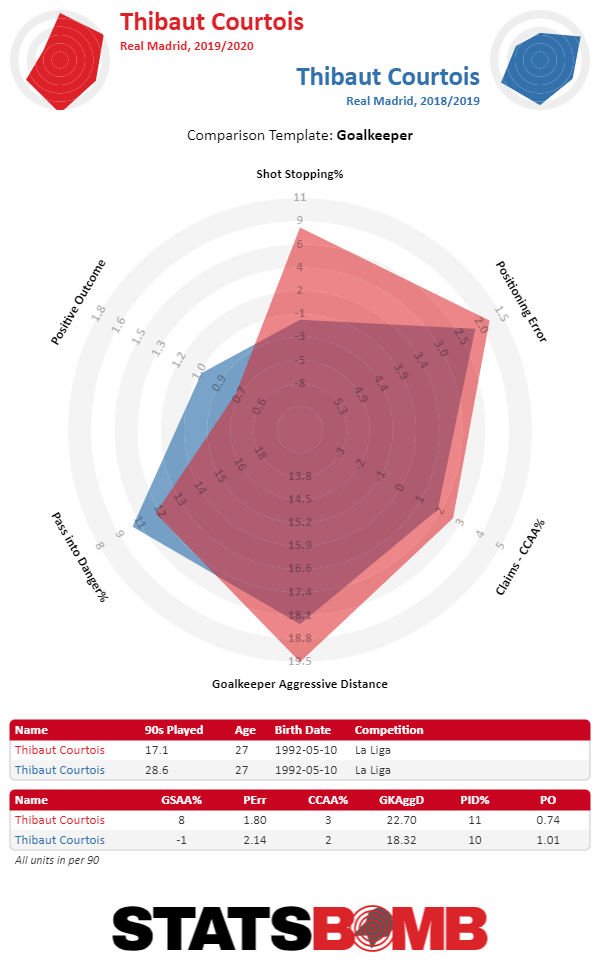 Compared to last year, his shot-stopping is up, his aggression as more of a sweeper is increasing and his claims percentage is rising. One area of his game that Courtois needed to improve was his aggressiveness coming off the line, and he has. He is now the most aggressive goalkeeper in La Liga when coming off his line to perform defensive actions outside his penalty area at 22.70 metres. He’s not peak Manuel Neuer in possession or when attempting to sweep up, but he looks much better. With his confidence back, he might just become the galáctico Madrid tried to sign in 2018 and even be the difference when it comes to deciding the La Liga title this season.
Compared to last year, his shot-stopping is up, his aggression as more of a sweeper is increasing and his claims percentage is rising. One area of his game that Courtois needed to improve was his aggressiveness coming off the line, and he has. He is now the most aggressive goalkeeper in La Liga when coming off his line to perform defensive actions outside his penalty area at 22.70 metres. He’s not peak Manuel Neuer in possession or when attempting to sweep up, but he looks much better. With his confidence back, he might just become the galáctico Madrid tried to sign in 2018 and even be the difference when it comes to deciding the La Liga title this season.
Jan Oblak
There is something mythical about Jan Oblak. He’s a cross between a man mountain and an octopus, doesn’t get as many headlines as he should and, despite his stoic exterior, pulls off the seemingly miraculous on a weekly basis. There are times when his goal seems impregnable. Compared to the other two, he appears to have a disproportionate amount of incredible saves, possibly due to an arm that seems to extend beyond the natural limits of the human body and reflexes that a cat would envy. And he seems to make these saves in clusters. Against Levante at the weekend, Paco Lopez described Oblak as “probably the best in the world” after he denied them the equalizer twice. Roger, the man he denied for the second, said “Oblak made two wonderful saves” and Simeone chimed in with “for us, he is the best in the world” while admitting Oblak saved their bacon. Interestingly, while Oblak's saves were no doubt impressive, they were not perhaps as decisive to the game as its participants felt them to be. 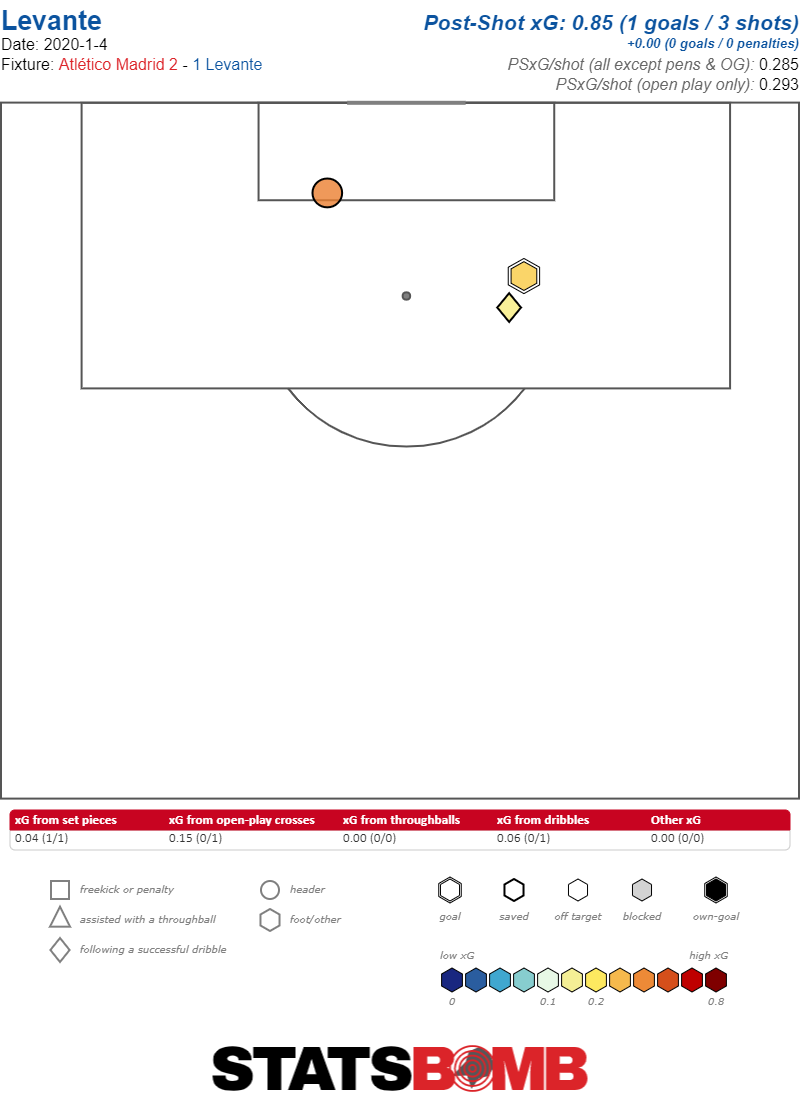 Atlético Madrid are in a period of transition into a more attacking side. And so Oblak’s numbers are down from his normal other-worldly self. He finished last year with 14 goals saved above average; no one else had more than 9. As such, the fact that he's currently below water with -1.82 goals scored above average more likely reflects a rough patch than a serious sign of concern. Plus, he's still conceding just 0.51 goals per 90, the best in the league for players with at least 600 minutes. His save percentage, 84, and his shot-stopping percentage, 11, remains the best in the league. All of which is to say that even in a down year, when Atleti are trying to be more attacking, Oblak still gets the benefit of playing behind a uniquely stellar defence that allows largely weak shots at goal. As Oblak has won the Zamora trophy three years in a row, his brilliance has become almost mundane in its consistency. Yet the club recognises it, signing the keeper to a new deal until 2023 with a release clause of €120 million. For as long as he is at Atletico Madrid, he will be a target for other teams and a threat to leave. Clubs have circled in the past but Simeone continues to keep them at bay. Allison was a key figure in turning Liverpool into Europe’s best team and Jan Oblak could certainly tip the scales for another club in need of help at the position. Especially if he can manage to get something even close to last season's Oblak; seriously, look at that radar.
Atlético Madrid are in a period of transition into a more attacking side. And so Oblak’s numbers are down from his normal other-worldly self. He finished last year with 14 goals saved above average; no one else had more than 9. As such, the fact that he's currently below water with -1.82 goals scored above average more likely reflects a rough patch than a serious sign of concern. Plus, he's still conceding just 0.51 goals per 90, the best in the league for players with at least 600 minutes. His save percentage, 84, and his shot-stopping percentage, 11, remains the best in the league. All of which is to say that even in a down year, when Atleti are trying to be more attacking, Oblak still gets the benefit of playing behind a uniquely stellar defence that allows largely weak shots at goal. As Oblak has won the Zamora trophy three years in a row, his brilliance has become almost mundane in its consistency. Yet the club recognises it, signing the keeper to a new deal until 2023 with a release clause of €120 million. For as long as he is at Atletico Madrid, he will be a target for other teams and a threat to leave. Clubs have circled in the past but Simeone continues to keep them at bay. Allison was a key figure in turning Liverpool into Europe’s best team and Jan Oblak could certainly tip the scales for another club in need of help at the position. Especially if he can manage to get something even close to last season's Oblak; seriously, look at that radar. 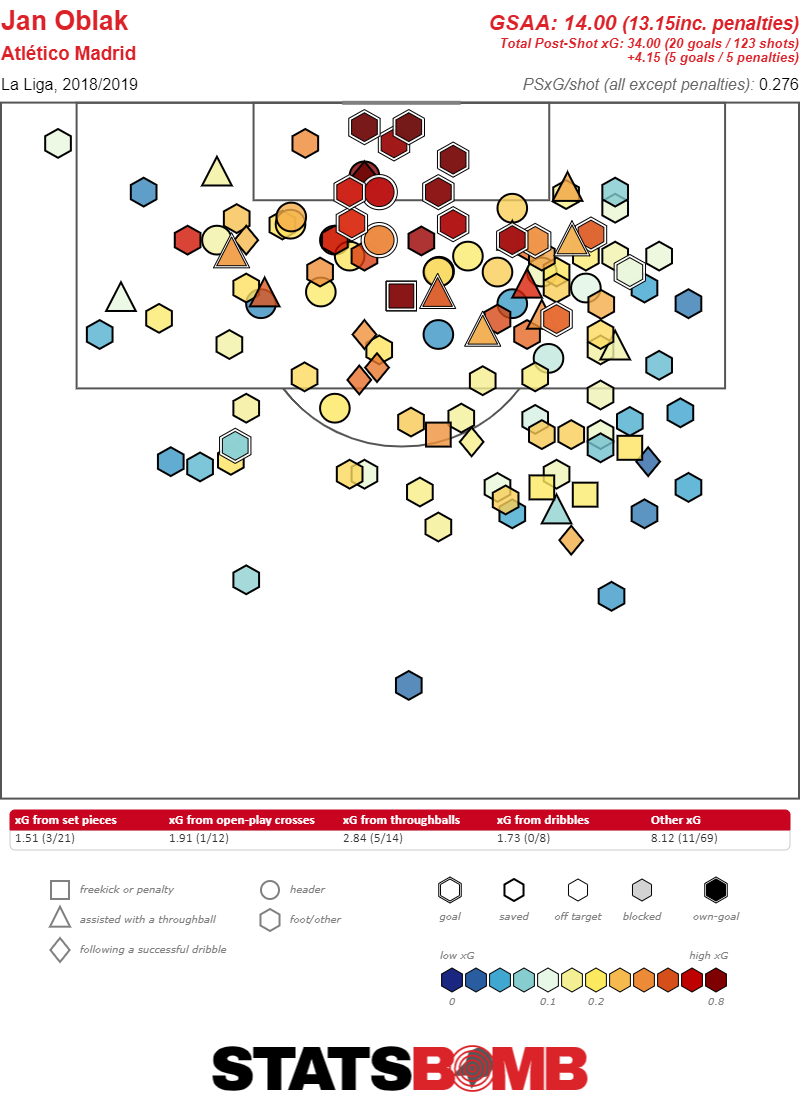 Marc-André ter Stegen Ter Stegen hasn’t had the best of years but remains a world class goalkeeper. Such is his role, that of a true sweeper-keeper, there tends to be more variance in his performances. If Oblak is a wall at one end of the scale and Courtois is in the middle, excelling at claiming crosses, shot-stopping and a little bit of passing then their German colleague is at the far end of the scale – he has the body of a goalkeeper and the brain of a central midfielder.
Marc-André ter Stegen Ter Stegen hasn’t had the best of years but remains a world class goalkeeper. Such is his role, that of a true sweeper-keeper, there tends to be more variance in his performances. If Oblak is a wall at one end of the scale and Courtois is in the middle, excelling at claiming crosses, shot-stopping and a little bit of passing then their German colleague is at the far end of the scale – he has the body of a goalkeeper and the brain of a central midfielder. 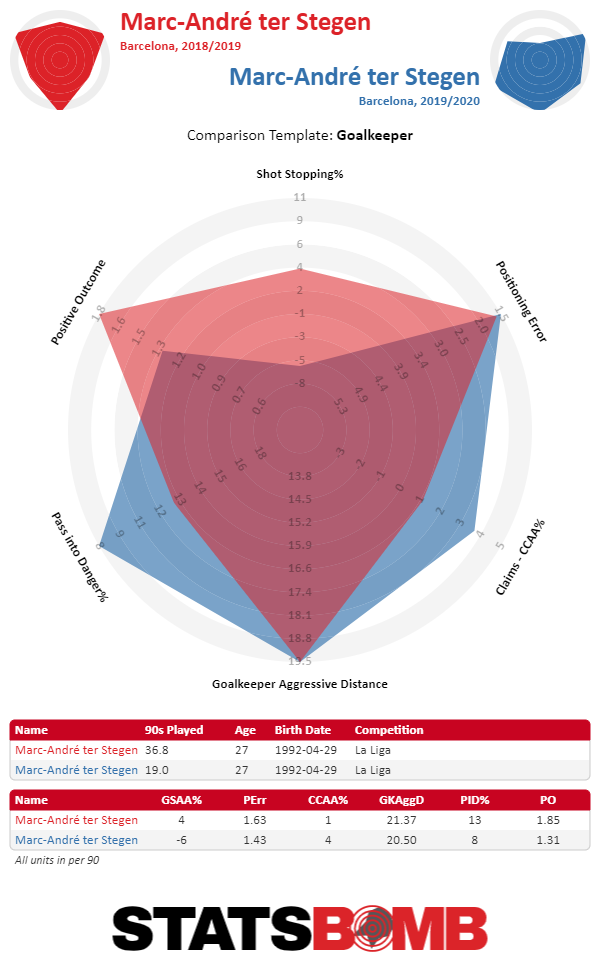 Whatever Ter Stegen lacks in shot-stopping prowess, and that isn’t to suggest he lacks much, he can make up for it with his feet. He is an ice-man when it comes to inviting opponents to press him before he springs a defender and gives his side numerical superiority as they build from the back. He passes the ball to teammates in danger positions just 8% of the time, which is almost half the league average of 15%. He is unflappable and has two assists this season. Given he has the lowest launch percentage in the league, the long passes he does make tend to be laser beams. Ter Stegen’s season to date, much like his Barcelona’s teammates, has been mixed. It hasn’t been helped by the fact that Jordi Alba has spent a lot of time on the sideline through injury and his replacement, Junior Firpo, has taken time to adjust. Clement Lenglet, who swooped in and stole Samuel Umtiti’s job from him looks vulnerable and could be handing his compatriot back his role if he doesn’t improve. The number of passes Ter Stegen launches out from the back (not counting goal kicks) is the lowest in the league at 24.3, followed closely by Courtois. The German acts like another outfield player and despite his shot-stopping ability falling off this season, his worth is made up in what he offers in the passing game. His passing percentage, 86, is the best in the league for keepers too. Who is the best goalkeeper in the league? It depends on what you’re asking your keepers to do. Each keeper mentioned has different skill sets but all of them are 27, most likely have at least some of their best years ahead of them and play for three of the best teams in the world. Cristiano is gone and Lionel Messi can’t continue to set the standard forever. But they have three of the world’s best keepers to hold down the fort until the next generation of elite attackers arrives in La Liga.
Whatever Ter Stegen lacks in shot-stopping prowess, and that isn’t to suggest he lacks much, he can make up for it with his feet. He is an ice-man when it comes to inviting opponents to press him before he springs a defender and gives his side numerical superiority as they build from the back. He passes the ball to teammates in danger positions just 8% of the time, which is almost half the league average of 15%. He is unflappable and has two assists this season. Given he has the lowest launch percentage in the league, the long passes he does make tend to be laser beams. Ter Stegen’s season to date, much like his Barcelona’s teammates, has been mixed. It hasn’t been helped by the fact that Jordi Alba has spent a lot of time on the sideline through injury and his replacement, Junior Firpo, has taken time to adjust. Clement Lenglet, who swooped in and stole Samuel Umtiti’s job from him looks vulnerable and could be handing his compatriot back his role if he doesn’t improve. The number of passes Ter Stegen launches out from the back (not counting goal kicks) is the lowest in the league at 24.3, followed closely by Courtois. The German acts like another outfield player and despite his shot-stopping ability falling off this season, his worth is made up in what he offers in the passing game. His passing percentage, 86, is the best in the league for keepers too. Who is the best goalkeeper in the league? It depends on what you’re asking your keepers to do. Each keeper mentioned has different skill sets but all of them are 27, most likely have at least some of their best years ahead of them and play for three of the best teams in the world. Cristiano is gone and Lionel Messi can’t continue to set the standard forever. But they have three of the world’s best keepers to hold down the fort until the next generation of elite attackers arrives in La Liga.
